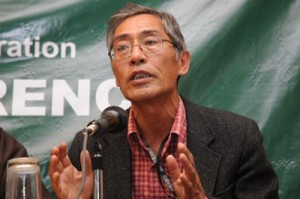By Thubten Samphel,
The Huffington Post
April 29, 2014
Official Chinese view of the Dalai Lama is well known. Successive party officials have called the Tibetan leader a “wolf in monk’s robes” or “a devil with a human face, but with a heart of a beast.” On the other hand, the Chinese Communist Party assumes the exalted status of being the “real Buddha” to the Tibetan people, and on this account it has a couple of times declared Lhasa, the capital of Tibet, the “happiest city” in China.
Since no survey has been done, we don’t know whether the ordinary Chinese population buy their government’s argument about the Tibetan spiritual leader, or the situation on the ground in Tibet. The consensus is that the vast majority of Chinese do not question the party’s views of the Dalai Lama, nor the conditions prevailing on the plateau.

However, a recent report, a collection of comments on the tightening restrictions on the roof of the world by Chinese microbloggers, reveals the unsettling questions that pop up in their minds when Chinese tourists are confronted with the grim reality in Tibet. Has Life Here Been Always Like This? is a report issued by the International Campaign for Tibet (ICT), an advocacy group based in Washington, D.C. The report says, “Despite authorities’ efforts to crack down on social media, ICT was able to collect hundreds of images and message from the popular Chinese microblogging site, Sina Weibo, using crowd-sourced perspective of Chinese tourists to further document the harsh security measures implemented in Tibet by Chinese authorities.”
The report is a survey of Internet chatter by Chinese tourists to Tibet from 2011 to 2012. It includes images of a highly militarized Tibet and the Chinese tourists’ expressions of shock, irritation and even fear at China’s bristling military muscle on display in Tibet. A Sina Weibo (Chinese version of Twitter) posting of 2011, quoted in the report, likened the situation in eastern Tibet to “a war zone.” The comment said, “Yesterday I drove along the Xianshul River fault line from Luhuo (Dranggo) to Chengdu, Tawu County was like a war zone. People’s Armed Police and Public Security standing along the street, heavily-armed Special Police at each door! We were told you can’t stay overnight in the county town, and you can’t stay on these streets!”
Another posting lamented, “On the way back to Lhasa from the lake my ID card was inspected multiple times…If you take a picture of a fire truck they’ll make you delete it…Think again about taking a picture of Special Police vehicle…What is wrong with this society? The cost of maintaining stability is truly high! (2012)”
China’s daily exercise of its military muscle in Tibet is in response to the peaceful protests that swept the plateau in 2008, followed by a series of self-immolations that started in 2009. Since that year to 15 April 2014, 130 Tibetans have set themselves on fire, calling for the return of the Dalai Lama and freedom for Tibet. China’s military response to these peaceful protests and individual acts of self-immolations seems disproportionate.
But even this is not enough for Beijing. The Chinese Communist Party now seemingly wants to silence the voice of the Dalai Lama in Tibet. Writing in November last year for Qiushi (Seeking Truth), the party journal, Chen Quanguo, the party chief of Tibet, said, “Work hard to ensure that the voice and image of the party is heard and seen over the vast expanses (of Tibet)… and that the voice and image of the enemy forces and the Dalai clique are neither seen nor heard.”
This could be an uphill task for the party. There are some Chinese who are amplifying the Dalai Lama’s voice in China. Beyond the radar of China’s censors and whispered in the din of China’s Internet chatter are expressions of Chinese support and sympathy. A film, The Dialogue, posted on YouTube and premiered in Hong Kong late this March, reveals that an increasing number of young Chinese on the mainland are embracing the Dalai Lama’s message of reconciliation and mutual respect.
The Dialogue is made by Wang Lixiong, a writer who is based in Beijing and married to Tsering Woeser, a tireless blogger for Tibet. The film grew out of the two conversations that Wang Lixiong organized between the Dalai Lama and netizens on the Mainland in 2010. Later, he organized a videoconference between the Dalai Lama and two Chinese human rights lawyers,Teng Biao in Shenzhen and Jiang Tianyong in Beijing.
The questions the two Chinese human rights lawyers and their compatriots put before the Dalai Lama are the concerns and anxieties Tibetans on both sides of the Himalayas grapple with. The Tibetan leader answered questions on his likely spiritual successor, whether Tibetans would be faithful to non-violence after his passing away, how the issue of Tibet could be resolved, the nature of Tibetan autonomy and relations between Tibetans and Chinese. 1,543 Chinese submitted more than 300 questions. 12,771 Chinese voted for the 10 best questions before the censors moved in.
These expressions of concern are a drop in the ocean, given China’s population and the multitude of challenges confronting the country. However, along with the trend of growing Chinese attraction to Tibetan Buddhism, these concerns have a real potential of guiding how China cures its Tibet headache.

